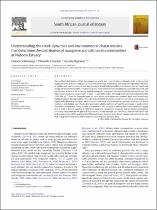| dc.contributor.author | Geldenhuys, Chanel | |
| dc.contributor.author | Cotiyane, Phumlile | |
| dc.contributor.author | Rajkaran, Anusha | |
| dc.date.accessioned | 2023-06-07T10:15:37Z | |
| dc.date.available | 2023-06-07T10:15:37Z | |
| dc.date.issued | 2016 | |
| dc.identifier.citation | Geldenhuys, C. et al. (2016). Understanding the creek dynamics and environmental characteristics that determine the distribution of mangrove and salt marsh communities at Nahoon Estuary. South African Journal of Botany, 107 ,137-147. https://doi.org/10.1016/j.sajb.2016.04.013 | en_US |
| dc.identifier.issn | 0254-6299 | |
| dc.identifier.uri | https://doi.org/10.1016/j.sajb.2016.04.013 | |
| dc.identifier.uri | http://hdl.handle.net/10566/9061 | |
| dc.description.abstract | The southern distributional limit for mangroves on the east coast of Africa is thought to be at the planted
mangrove forest at Nahoon Estuary (33° S) in the Eastern Cape, South Africa. This study investigated the influence
of a tidal creek on the intertidal zone and the physical and biological differences between the salt marsh and
mangrove forest communities at Nahoon Estuary. Three transects were established across the tidal creek and
one transect in each of the following habitats mangrove, mangrove–salt marsh, and the salt marsh area. The
tidal creek introduced oxygenated (~6 mg.l−1) and saline water with high levels of total suspended solids
(120–424 g.l−1) into the intertidal zone. In areas where tidal water was retained, algal mats formed over
pneumatophores during summer. The vegetation distribution in the mangrove–salt marsh community was
significantly affected by elevation, ammonium concentration, and porewater temperature while the salt marsh
vegetation distribution was influenced by porewater salinity, sediment, pH and the percentage of sand content.
Porewater nitrogen was mostly present as ammonium, and phosphate concentrations were moderate ranging
from 1.3 μM in the salt marsh to 3.7 μM in the mangrove community. Mangrove and salt marsh communities
are clearly constrained by the physical characteristics of the intertidal area (elevation) and this will ensure that
both communities will be maintained at Nahoon Estuary. However with climate change and sea level rise, this
may change in the long term with mangroves expanding into elevated areas. | en_US |
| dc.language.iso | en | en_US |
| dc.publisher | Elsevier | en_US |
| dc.subject | Biodiversity | en_US |
| dc.subject | Conservation | en_US |
| dc.subject | South Africa | en_US |
| dc.subject | Biology | en_US |
| dc.subject | Avicennia marina | en_US |
| dc.title | Understanding the creek dynamics and environmental characteristics that determine the distribution of mangrove and salt marsh communities at Nahoon Estuary | en_US |
| dc.type | Article | en_US |

